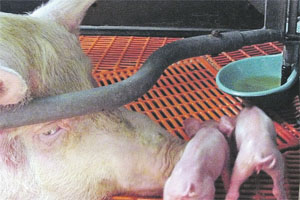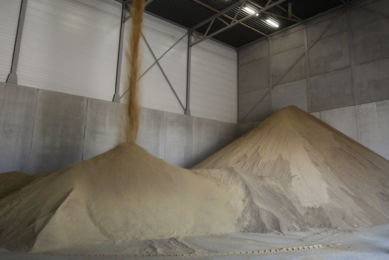Ways to ensure sufficient milk production

Genetics and swine husbandry have moved on apace in 20 years, yet the swine industry globally is struggling with a lack of improvement in overall litter performance. How to deal with multi-factorial problems like MMA or PHS?
A lack of sow milk is often blamed for a lack of improvement and tell-tale signs are retarded growth, diarrhoea and an increased incidence of runts and mortality. Some problems are more pronounced in certain regions of the world or can be attributed to specific management factors. This article provides an insight into the causes of milk production problems and encourages producers to check out potential pitfalls.
Calcium concerns
The problem of MMA (Mastitis, Metritis, Agalactia) is actually often associated with a lack of calcium in sows around parturition. This deficiency is the result of an excess of calcium during pregnancy which leads to impaired activity of the calcium metabolism around farrowing. It is typically associated with delayed farrowing or with sows with hard udders around and after parturition and is often accompanied by vulva discharge.
In most countries the calcium level in diets for pregnant sows has decreased to less than 7.0 g/kg, resulting in less MMA incidence. In some regions, like the UK and Eastern Europe, higher Ca levels (>8.0 g/kg) are typically found in gestating sow diets, and problems with MMA are more common. In Germany, MMA is frequently seen in the southern part of the country, where the drinking water contains high amounts of calcium. Dietary calcium and phosphorus supply must be optimised for each stage of the reproductive cycle. Improved hygiene and better climatic controls with fewer draughts in buildings have reduced the incidence of MMA but it is still a threat where there is an excess of calcium during pregnancy.
Premature dying off
In some cases the udder dries up and milk production stops three to five days after parturition. Known as Periparturient Hypogalactia Syndrome (PHS), this leads to piglet weight loss and mortality and increases the need for fostering. Large amounts of feed (>4.0 kg/day) in the last stage of pregnancy to boost birth weights – which has been common practice in Denmark for example – can lead to PHS. The disadvantage, however, is the induction of ‘pregnancy diabetes’ in the sows. This may cause a reduced glucose tolerance, as shown by Prof Bas Kemp, Wageningen University, back in 1994 and shown in Table 1 . Oedema of udder and vulva may be seen during the last week of pregnancy. Other causes that may aggravate the problem of PHS are low crude fibre levels in the feed, leading to constipation, hard faeces, an overgrowth of E. coli and/or clostridium. These bacteria produce endotoxins that lower feed intake and make sows feel sick. The toxins are stored in the body and the sow retains water to dilute these toxins. This causes oedema which will disappear two or three days post partum. Milk production slowly diminishes and stops. Piglets then lose weight and may starve to death. Excessive sow body condition is also a risk factor for fatty liver syndrome and PHS. To avoid this, feed intake should be gradually increased in the first ten days of lactation.
Research has shown that a gradually increased feeding scheme versus ad lib feed intake during lactation reduced the incidence of PHS from 23% to 7%. Optimising feed intake during lactation is a key factor to prevent PHS as there is a negative relationship between feed intake during gestation and that during lactation. This can be achieved by using a restricted feeding scheme during gestation and by measuring back fat thickness regularly so that sows do not have high body fat stores as they enter the farrowing house.
Temperature and management factors
Variations in temperature in the farrowing house can cause problems with milk intakes. Piglets will not be encouraged to visit the sow and feed if the temperature around her is ‘cold’ relative to their warm bed. A new system used in Denmark encouraged newborn piglets to stay in their warm beds but unfortunately the exit was too narrow and piglets did not visit the sow often enough. The udder was insufficiently stimulated which limited milk production. In the Netherlands, problems with milk yield are scarce and are usually associated with diseases such as influenza, PRRS and PCV2. In some cases, problems occur in the Netherlands with piglet diarrhoea caused by rotavirus, E. coli or clostridium infection. Insufficient piglet vitality at birth will lead to insufficient intake of colostrum and milk. This also diminishes the milk production, leading to starvation of piglets. Problems with sow faecal consistency around parturition are frequently seen in the Netherlands, especially on farms using wet mash feeds. For sows on wet feeds, water intake is associated with feed intake. Lowering the feed allowance around parturition also decreases the water intake, because these sows are not used to drinking water from nipple drinkers. Spray drinkers at the bottom of the feed trough may also cause insufficient water intake. Solutions include placing a separate water bowl underneath the trough or a biting nipple above the trough. Advanced wet feed installations are able to supply additional drinking water around the time of parturition.
Multi-factorial syndromes
One should be aware that PHS and MMA are multi-factorial syndromes and factors like housing, climate, stress, hygiene, infection pressure and drinking water play a big role in sow milk production and subsequent piglet performance. Optimising nutrition is a key factor to prevent MMA and PHS. This can be achieved by using the right feeding curve, optimising calcium and phosphorus supply for each stage of the reproductive cycle, using good fermentable crude fibres in sow diets, and ensuring a smooth transition to the lactation diet.











